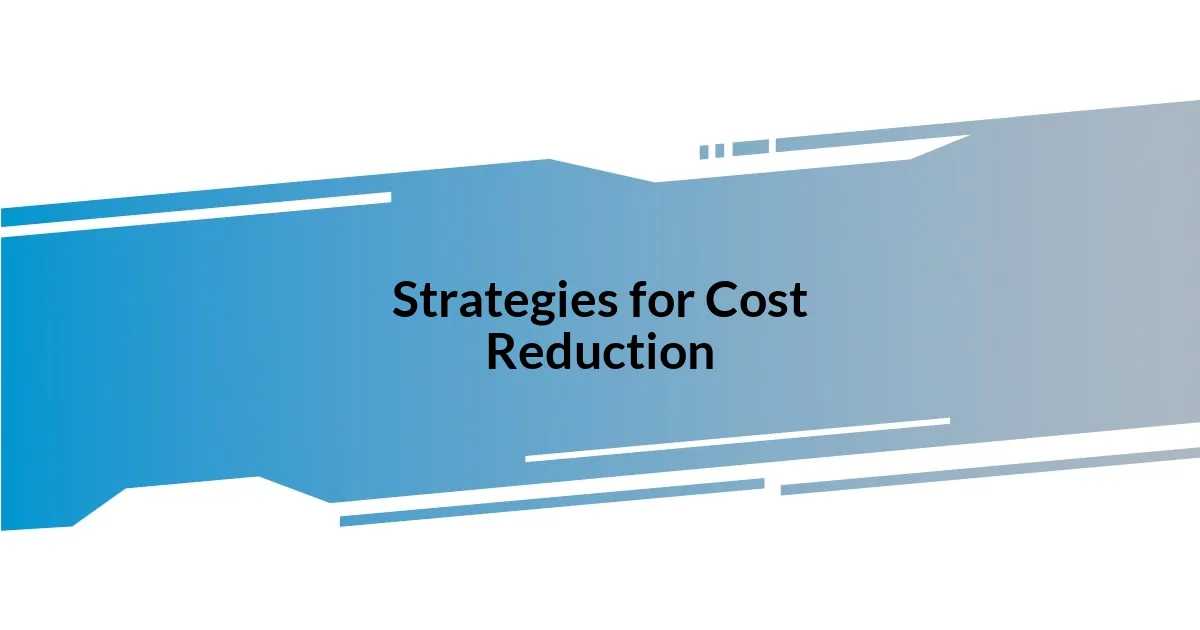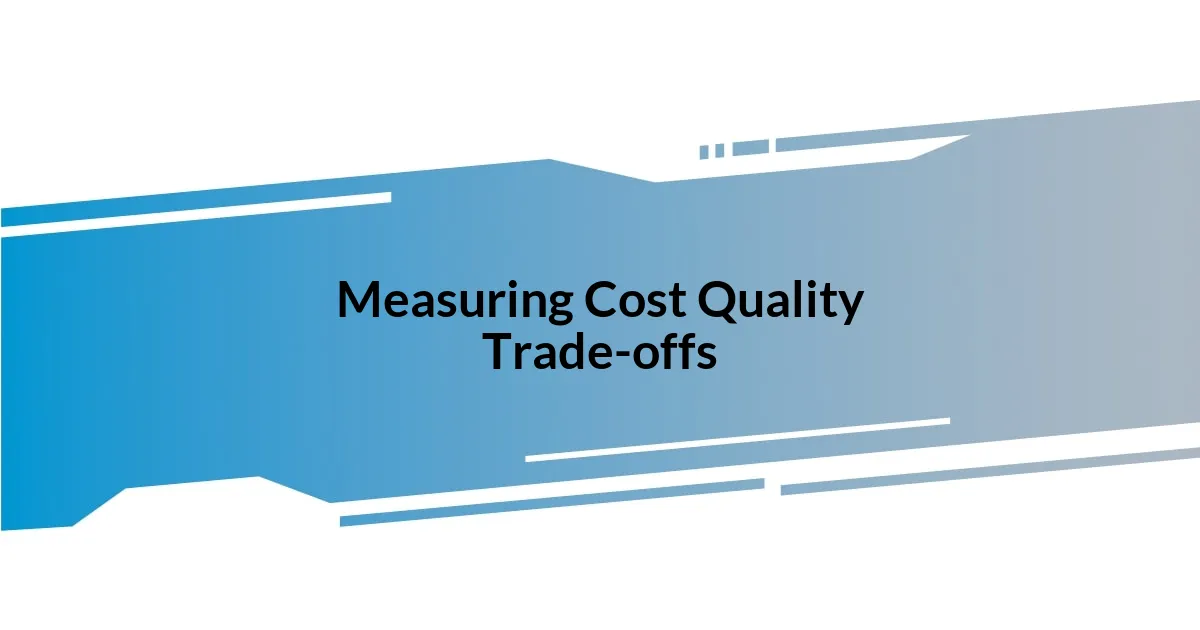Key takeaways:
- Balancing cost and quality requires investment in critical areas to avoid long-term issues from cost-cutting.
- Understanding both direct and indirect costs is essential for effective budgeting and financial health.
- Incorporating feedback and structured techniques like the PDCA cycle can significantly improve project outcomes and team morale.
- Utilizing tools like a cost-quality matrix helps visualize trade-offs, leading to better decision-making regarding long-term value.

Understanding Cost and Quality Balance
Balancing cost and quality can feel like walking a tightrope. I remember when I was tasked with sourcing materials for a crucial project; the temptation to cut corners was ever-present. But each time I considered reducing quality to save money, I recalled past experiences where subpar choices led to significant longer-term expenses.
I’ve often wondered why we sometimes gravitate toward cheaper options, despite knowing the potential pitfalls. For instance, in my early days, I opted for a budget supplier that promised quick delivery. Initially, it seemed like a win, but the product failed to meet standards, forcing me into a costly redo. This taught me that cost-cutting shouldn’t come at the expense of reliability.
Striking the right balance means being willing to invest in quality where it truly counts. I’ve learned that it’s essential to identify which areas warrant a higher investment and which can be minimized without sacrificing integrity. This approach has allowed me to create lasting relationships with vendors, ensuring that both cost and quality are aligned for optimal outcomes. Wouldn’t it be great if we all approached these decisions with a clear understanding of their long-term impacts?

Identifying Key Cost Factors
Identifying the key cost factors in any project is essential for effective budgeting. I recall a time when I constructed a detailed cost breakdown for a large event. Initially, I underestimated the logistical costs, which led to a scramble at the last minute. Having clarity on factors like venue pricing, catering, and technology requirements can prevent these last-minute surprises.
When assessing costs, I always emphasize the importance of analyzing both direct and indirect expenses. For example, in a previous role, I often focused too heavily on upfront costs, ignoring the ripple effects of maintenance and support. This oversight turned into a lesson when I had to deal with high maintenance fees in my subsequent projects. Understanding these nuances not only aids in accurate budgeting but also supports long-term financial health.
I also learned that labor costs can significantly influence overall budgets. I remember negotiating with a team of freelancers, searching for the sweet spot between quality output and reasonable pay. This experience highlighted how investing in skilled labor ultimately saves time and resources, reinforcing that the right balance can lead to more satisfactory results. Identifying these key factors ensures I navigate costs more strategically without compromising quality.
| Cost Factor | Impact on Quality |
|---|---|
| Materials | Using high-quality materials increases durability and performance. |
| Labor | Skilled laborers contribute to the overall quality of the final product. |
| Logistics | Effective logistics can prevent delays and enhance overall productivity. |
| Maintenance | Investing in maintenance reduces future costs and longevity of products/services. |

Evaluating Quality Criteria
Evaluating quality criteria is a pivotal step in my decision-making process. I’ve come to realize that just looking at the price tag often leaves out essential details. For instance, I once evaluated a supplier based solely on their low prices. I quickly learned that their products had a higher failure rate, leading to frustration and wasted resources. This incident underscored the importance of criteria such as reliability, performance, and customer service alongside pricing.
When I assess quality, I always consider the following criteria:
- Durability: I prioritize materials that stand the test of time, avoiding the aggravation of frequent replacements.
- Performance: I look for products that not only meet but exceed industry standards, which often translates to better outcomes in my projects.
- Vendor Support: Strong customer service can make all the difference; knowing someone is there to assist can alleviate a lot of stress.
- User Feedback: I value reviews and testimonials from previous customers; their experiences can offer insights I might not have considered.
- Certifications: I take certification seriously; industry-standard certifications often indicate a commitment to quality that’s worth investing in.
By keeping these criteria in mind, I navigate the landscape of cost and quality with much more confidence, ensuring I make choices that will pay off in the long run.

Strategies for Cost Reduction
It’s fascinating how small changes can lead to significant cost savings. I once decided to reevaluate our office supply contracts and discovered we were overspending on everyday items. By simply negotiating bulk rates and consolidating orders, we managed to cut those costs by nearly 30%. This experience taught me that a proactive approach toward supplier relationships can yield remarkable results without sacrificing quality.
Another effective strategy I’ve found is to embrace technology for efficiency. In a past project, we implemented an inventory management system that streamlined our processes. The initial investment was minimal compared to the savings generated from reduced waste and better resource allocation. It made me realize how leveraging technology isn’t just about keeping up with trends, but rather an essential move for smarter budgeting.
I’ve also had my share of “trial and error” moments. A few years back, I attempted to source materials based on the lowest bids, thinking I could save money. What I encountered was a series of delayed deliveries and compromised quality, leading to a project timeline derailment. This experience reinforced the lesson that while cutting costs is crucial, it’s equally important to consider the long-term implications of those choices. Isn’t it worth spending a little more upfront to avoid future headaches?

Incorporating Quality Improvement Techniques
Incorporating quality improvement techniques into my processes has been transformative. Once, I introduced regular feedback sessions with my team to identify areas for improvement. This not only fostered an open communication environment, but it brought to light issues I hadn’t even considered. I realized that when everyone feels valued, the quality of our work improves exponentially.
One technique that really caught my attention was the Plan-Do-Check-Act (PDCA) cycle. Initially, I was skeptical about following a structured approach in project management, but once I tried it, the clarity it provided was undeniable. By planning meticulously, executing thoughtfully, checking our results, and acting on the findings, we were able to refine our approaches continuously. Have you ever wondered if a simple shift in methodology could unlock potential you didn’t know existed?
I also embraced continuous training for my team as a quality enhancement method. During a challenging project, we invested time in upskilling our staff in new technologies. This not only boosted their confidence but significantly improved our output quality. Seeing the team rise to the occasion fueled my belief that investing in human capital pays dividends in both quality and morale. Isn’t it amazing how empowering your team can elevate not just their skills but also the overall quality of your projects?

Measuring Cost Quality Trade-offs
Measuring the trade-offs between cost and quality can feel like walking a tightrope. In one of my earlier roles, I faced a situation where we had to choose between a cheaper vendor for a critical component and a more established one with a higher price tag. I’ll never forget the anxiety of that decision; selecting the cheaper option initially seemed appealing, but when I considered the potential impacts on our product’s reputation, it became clear that the cost savings were not worth the risk.
I often utilize a cost-quality matrix to visualize trade-offs. This tool has been invaluable in helping me assess how variations in cost can influence quality outcomes. During a recent project, I mapped out several options and saw that investing an additional 15% in a more reliable supplier dramatically reduced the risk of returns and customer complaints. It was a lightbulb moment that underscored how viewing costs through this lens allows for a fuller understanding of long-term value and customer satisfaction.
Sometimes, I ask myself whether it’s better to gamble on low-cost solutions that might present short-term gains or to invest in quality that ensures long-term loyalty. I had this bitter experience when I tried to cut costs on a marketing campaign, only to see poor engagement rates. Reflecting back, I realized that skimping on quality undeniably harmed not just the campaign but also the trust we’d built with our audience. In the end, I learned that truly balancing cost and quality requires deep introspection and a commitment to prioritizing what matters most.